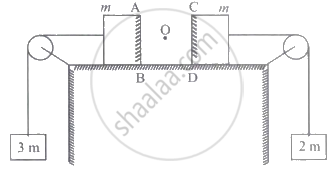Advertisements
Advertisements
Question
Using the second law of motion, derive the relation between force and acceleration. A bullet of 10 g strikes a sand-bag at a speed of 103 m s-1 and gets embedded after travelling 5 cm. Calculate
(i) the resistive force exerted by the sand on the bullet
(ii) the time is taken by the bullet to come to rest.
Solution
Rate of change of momentum = `("Change in momentum")/("Time taken")`
= `("m"("v" - "u"))/"t"` ...........(i)
using v = u + at
∴ a = `("v" - "u")/"t"` .............(ii)
From (i) and (ii), we get
Rate of change of momentum = ma
According to newton's second law of motion
Force ∝ rate of change of momentum
F ∝ m × a
Then F = K ma; K is a constant
∴ F = ma
Here mass of bullet, m = 10 g = 0.01 kg
Initial speed u = 103 ms−1
Final peed v = 0
Distance travelled, s = 5 cm = 0.05 m
(i) Using v2 − u2 = 2as, we get
0 − (103)2 = 2 × a × 0.05 = 0.1a
or a = `(-10^6)/0.1 = -10^7 "ms^-2"`
Therefore, the resistive force exerted by the sand on the bullet = − (Force exerted by bullet on sand)
= −ma = − 0.01 × (107) N = +105 N
(ii) Time taken by the bullet to come to rest,
t = `("v" - "u')/"a"`
= `(0 - 10^3)/-10^7`
s = 10−4 s
APPEARS IN
RELATED QUESTIONS
An automobile vehicle has a mass of 1500 kg. What must be the force between the vehicle and road if the vehicle is to be stopped with a negative acceleration of 1.7 m s−2?
A bullet of mass 10 g travelling horizontally with a velocity of 150 m s−1 strikes a stationary wooden block and comes to rest in 0.03 s. Calculate the distance of penetration of the bullet into the block. Also calculate the magnitude of the force exerted by the wooden block on the bullet.
How much momentum will a dumb-bell of mass 10 kg transfer to the floor if it falls from a height of 80 cm? Take its downward acceleration to be 10 m s−2.
Two persons manage to push a motorcar of mass 1200 kg at a uniform velocity along a level road. The same motorcar can be pushed by three persons to produce an acceleration of 0.2 m s−2. With what force does each person push the motorcar? (Assume that all persons push the motorcar with the same muscular effort.)
How long will it take a force of 10 N to stop a mass of 2.5 kg which is moving at 20 m/s ?
Name the law involved in the following situation:
a body of mass 5 kg can be accelerated more easily by a force than another body of mass 50 kg under similar conditions.
State and explain Newton’s second law of motion.
A passenger in a moving train tosses a coin which falls behind him. This shows that the motion of train is :
Complete a sentence and explain it.
During a collision, ______ remains constant.
Two blocks each of mass m lie on a smooth table. They are attached to two other masses as shown in the figure. The pulleys and strings are light. An object O is kept at rest on the table. The sides AB and CD of the two blocks are plane and made reflecting. The acceleration of two images formed in those two reflecting surfaces with respect to each other is ______.

